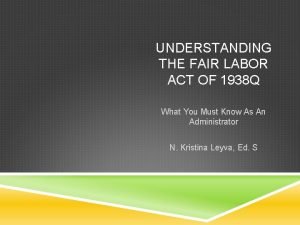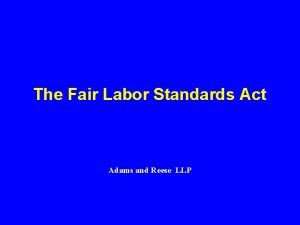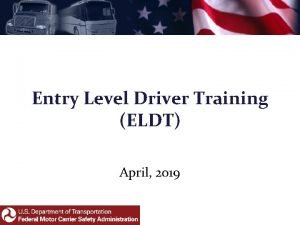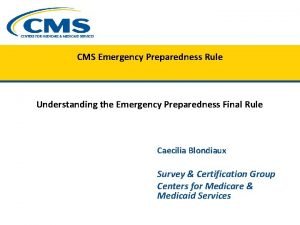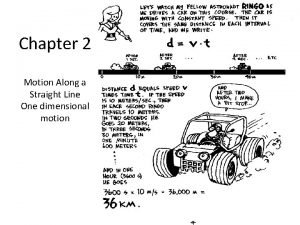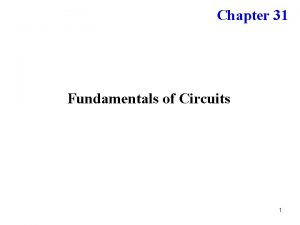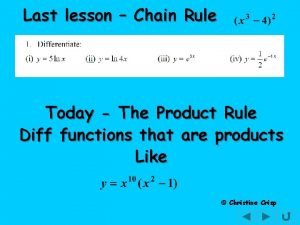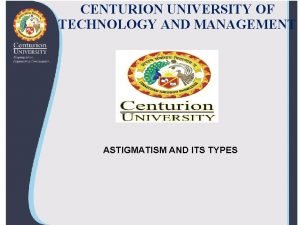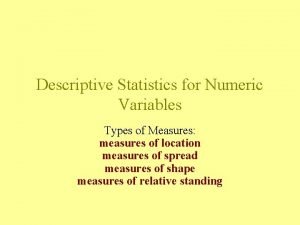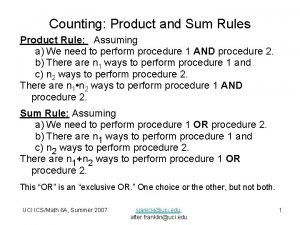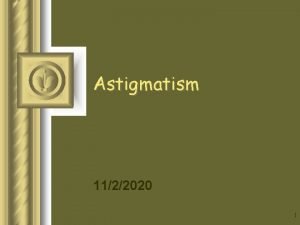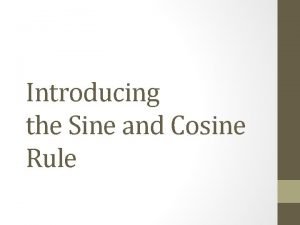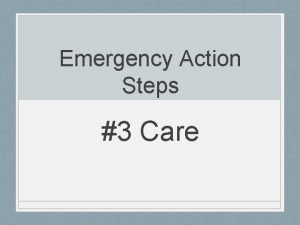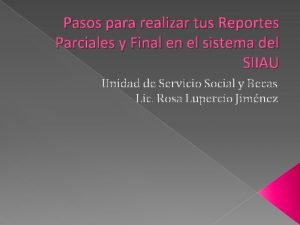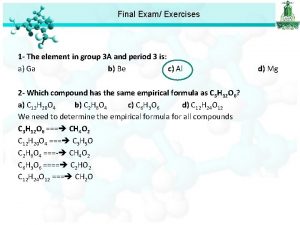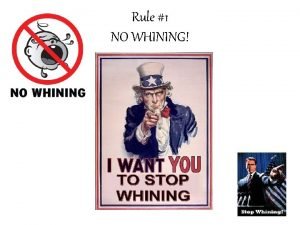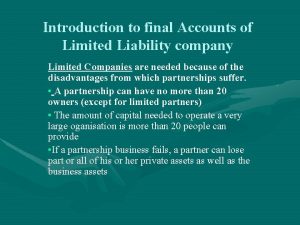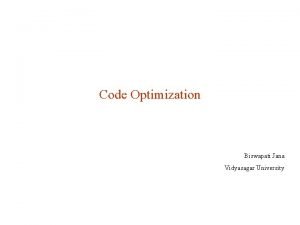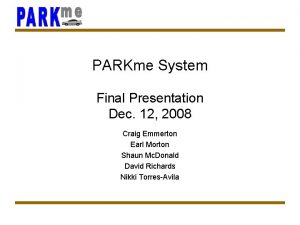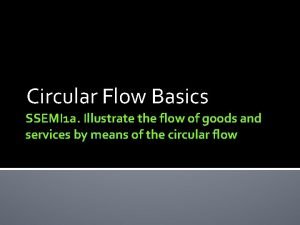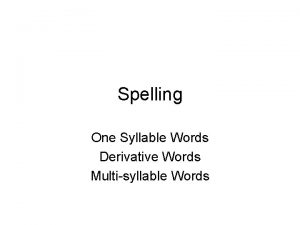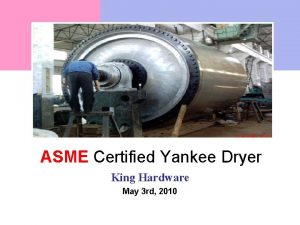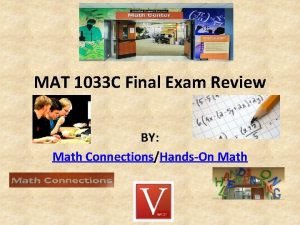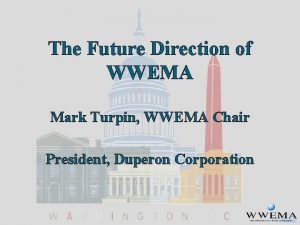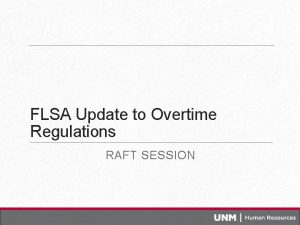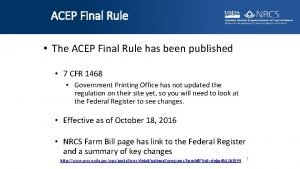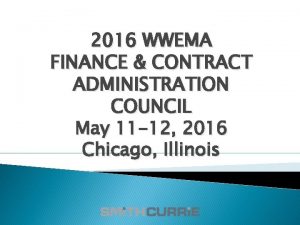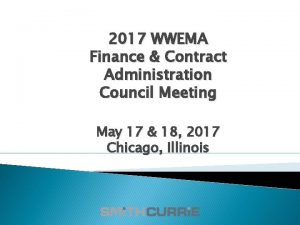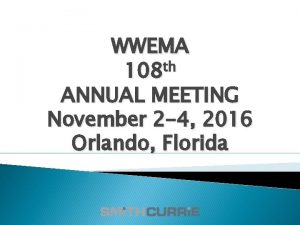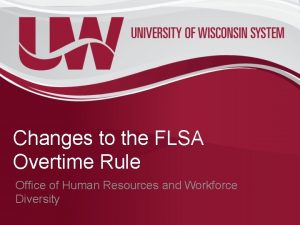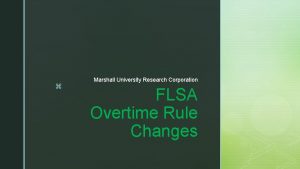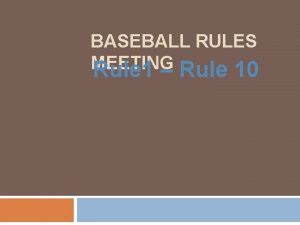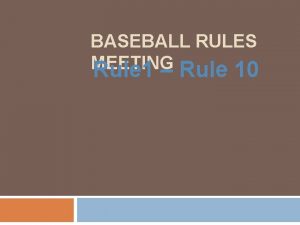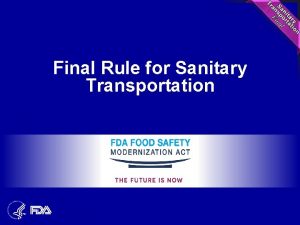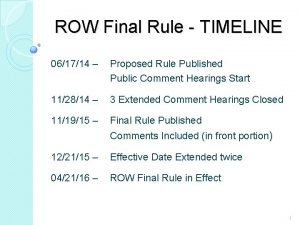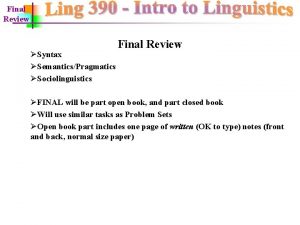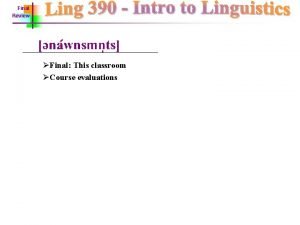WWEMA FLSA Final OT Rule What the FLSA






























































































- Slides: 94


WWEMA FLSA Final OT Rule What the FLSA Requires Presented By: Nicole Croddick, Esq. HR Learning Center LLC Materials Developed by: Melissa Fleischer, Esq. HR Learning Center LLC 914 -417 -1715 HRLearning. Center. com © 2016 HR LEARNING CENTER LLC

Agenda n n n n Final Rule on Overtime Classification as Exempt vs. Non-Exempt Salary Level Test Salary Basis Test Job Duties Test Executive Exemption Administrative Exemption Learned Professional Exemption Computer Employee Exemption Highly Compensated Employees Exemption Court Cases Conclusion Questions

Misclassification: Hot Topic Even more so Now with Final FLSA OT Rule n n Always been an important issue Even more so now that DOL issued Final OT Rule DOL estimates 80% of employers don’t comply with FLSA DOL set aside money in budget Overview of what you need to know © 2016 HR LEARNING CENTER LLC n

“Hanna Humanresources” n n n Cindy CEO of Waste Water Management LLC needs to know how to deal with the new final OT rule and which of her employees to re-classify based on the new rule She must determine which employees are exempt and which are nonexempt as a result of the Final Rule Very overwhelmed, joins our seminar

FAIR LABOR STANDARDS ACT n n n Federal law overseen by DOL Provides protection for employees in many ways including: Overtime Minimum wage Recordkeeping requirements Child labor laws

FLSA n n Not required to pay overtime to exempt employees Required to pay minimum wage to nonexempt employees No overtime for Saturdays, Sundays, holidays, evenings or regular days of rest, unless overtime hours are worked on such days State Laws

History of Proposed Revisions and Final Rule n n n March 2014 Pres. Obama issues Executive Order Directs Secretary of Labor to “modernize and streamline the existing overtime regulations” to be more “consistent with the intent of the Act. ” Monday, July 6, 2015 DOL published Notice of Proposed Rulemaking (NPR) Last revision to FLSA in 2004 Increased salary level test to not less than $455 per week ($23, 660 annually) The DOL has updated the salary level requirements seven times since 1938

Effect on Employers n n n Estimated that over 5 million, currently exempt, salaried employees affected by this increased salary threshold Employers will be paying much more In either OT or Raising the workers salaries so they meet the new threshold National Retail Foundation estimates could cost employers more than 800 million to convert from exempt to non-exempt and pay OT

4 Changes in Final Rule n n Salary level test threshold increased for exempt employees Salary to be considered highly compensated employee (HCE) increased Provides a mechanism to automatically update the salary and compensation thresholds on an annual basis Amends the salary basis test to allow employers to use nondiscretionary bonuses and incentive payments (including commissions) to satisfy up to 10 percent of the new standard salary level

Changes to Salary Threshold for Salary Level Test

Three (3) Tests n n n Salary Level Test; and (remember and not or) Salary Basis Test; and Job Duties Test

Salary Level Threshold Proposed Changes n n Salary level test by 2016 not less than $913 per week ($ 47, 476 annually) rather than current not less than $455 per week ($23, 660 annually) Still have to meet the other two tests Paid on a salary basis; AND Employee must meet the “job duties test”.

Other Changes n n Highly Compensated Employees $134, 004 or more (which must include at least $ 913 per week paid on a salary or fee basis) Up from current $100, 000 or more (which must include at least $455 per week paid on a salary or fee basis) Customarily and regularly perform at least one of the duties of an exempt executive, administrative or professional employee

Other Changes n n n To prevent the levels of salary level test from becoming outdated DOL includes a mechanism Automatically updates the standard salary level requirement every three years Standard salary level will be updated to maintain a threshold equal to the 40 th percentile of weekly earnings of full-time salaried workers in the lowest-wage Census Region Also, includes mechanism for automatically updating the HCE compensation level to maintain the threshold equal to the 90 th percentile of annual earnings of full-time salaried workers nationally

What Final Overtime FLSA Rule Means for Employers? n n n Choice for Employers Either up salary to new threshold of not less than $913 a week, or Up salary to where threshold will be in three years, or Convert to non-exempt and pay OT to all employees between $455 per week and $913 a week, or Convert to non-exempt but prohibit any OT work

Communication is Key n n n Make clear this re-classification is based on changes to the law Put positive spin on it You still are as important Now you get more money paid as overtime when you work extra hours Provide training so they understand how to accurately report hours No need to punch time clock

Communicate Classification to Applicants and Employees

Section 13(a)(1) of the FLSA n n n Provides exemption from both minimum wage and overtime pay for employees that are employed as bona fide executive administrative professional and outside sales employees. Certain computer employees © 2016 HR LEARNING CENTER LLC

Three-Part Test n n Salary level not less than $455 per week ($23, 660 annually) Final Rule increase to not less than $913 per week ($ 47, 476 annually) Paid on a salary basis; AND Employee must meet the “job duties test”.

To Be Exempt Salary Level not less than $913 per week Paid on a Salary Basis Meets the Duties Test

Exceptions-Only Need Duties Test for These n n Lawyers practicing law Doctors practicing medicine Teachers Outside Sales Employees. Commissions

Final Rule n n n Salary level not less than $913 per week ($ 47, 476 annually) Paid on a salary basis; AND Employee must meet the “job duties test”.

Can Commissions Be Added to Salary to Meet Salary Threshold? n n n Yes Final rule changes the regulations Now allows nondiscretionary bonuses and incentive payments (including commissions) to satisfy up to 10 percent of the standard salary test requirement For employers to credit nondiscretionary bonuses and incentive payments (including commissions) toward a portion of the standard salary level test Such payments must be paid on a quarterly or more frequent basis

Case Scenario n n Susie works for you as an assistant manager She earns a salary of $65, 000 a year You classify her as exempt because she is “salaried” Is this correct?

Answer n n No Susie is not exempt just because she is salaried Just because she is salaried does not mean that she is exempt Many non-exempt employees are salaried

Does being Salaried Equate to Being Exempt Q Can you not pay an employee overtime just because they are salaried? as exempt because she is “salaried” Is this correct? You classify her as exempt because she is “salaried” No Is this correct? Being salaried is only one of the tests They would also have to meet the salary level test and the duties test A

Case Scenario n n But Susie is not only salaried but also is an assistant manager Doesn’t that mean that she is exempt and not entitled to overtime?

Answer n n n No Susie is not exempt Just because her title has the word manager in it, does not mean she is exempt She still must meet the duties test And be salaried And meet salary level test making at least $ 47, 476 annually n n n Primary duty must be managing the enterprise, or managing a customarily recognized department or subdivision of the enterprise; Must customarily and regularly direct the work of at least two or more other full-time employees or their equivalent; and Must have authority to hire or fire other employees

Job Title Not Determinative

Do Not Make the Mistake of Classifying Based on Job Title n n 1, 700 current and former assistant store managers in California commenced a class action against Staples Inc. Alleged that the stores misclassified assistant managers as exempt under overtime pay regulations Settled for $38 million Staples, Inc. denied the claims and admitted no wrongdoing

Paid on a Salary Basis

What Does Paid on a “Salary Basis” Require n n n Employee regularly receives predetermined amount of compensation each pay period Amount employee receives cannot be reduced because of variations in quality or quantity of their work Exempt employee must receive full salary with no deductions for any week they perform any work even just one hour

Case Scenario n Jenny is an exempt employee in your office. She needs to leave the office Friday at 12 pm to care for her child. Can you dock her pay for the ½ day that she is not working?

Answer n n n You cannot dock Jenny for the ½ day she was not at work You can never dock an exempt employee’s pay, unless you do so for the few select permissible reasons Even then you can only dock for a full day and not a ½ day

Permissible Deductions from Exempt Employee Pay n n n n Absent from work for one or more full days for personal reasons other than sickness or disability; Absences of one or more full days due to sickness or disability if deduction is made in accordance with a bona fide plan, policy or practice Jury or Witness Fees Military Pay Infractions of Safety Rules of Major Significance Unpaid Disciplinary Suspensions of one or more full days Initial or Terminal Week of Employment Family and Medical Leave Act.

White-Collar Exemptions

Executive Exemption n n Compensated on a salary basis; At a salary level not less than $455 per week going up to not less than $913 per week ($47, 476 annually); AND Primary duty must be managing the enterprise, or managing a customarily recognized department or subdivision of the enterprise; Must customarily and regularly direct the work of at least two or more other full-time employees or their equivalent; and Must have authority to hire or fire other employees

Executive Exemption

Primary Duty n n n n “Primary duty” means the: Principal Main Major or Most important duty that the employee performs Determination of an employee’s primary duty should be based on all the facts in a particular case, with the major emphasis on the character of the employee’s job as a whole.

Primary duty must be managing the enterprise “Management Activities” n n n Interviewing, selecting, and training of employees; Setting and adjusting their rates of pay and hours of work; Directing the work of employees; Maintaining production or sales records; and Efficiency for purpose of recommending promotions or other changes in status; Handling employee complaints and grievances; n n n Disciplining employees; Planning the work; Determining the techniques to be used; Apportioning work among the employees; Determining the type of materials, supplies, machinery, equipment or tools to be used or merchandise to be bought, stocked and sold; Controlling the flow and distribution of materials or merchandise and supplies;

What does Customarily and Regularly Mean? n Greater than occasional but less than constant n Includes work normally done every workweek n Does not include isolated or onetime tasks

What does Two or More Employees Mean? n Two full-time employees or their equivalent

Two or More Employees n n n The phrase “two or more other employees” means two full-time employees or their equivalent For example, one full-time and two part-time employees are equivalent to two full-time employees Supervision could even be distributed among two, three or more employees, but each supervisor or manager must customarily and regularly direct the work of two or more other full-time employees or the equivalent. Department of Labor provides this example: Let’s say you have a department with five full-time nonexempt workers. To meet the exemption they may have up to two exempt supervisors if each supervisor directs the work of two of those workers

Hire or Fire

Factors to be considered in determining whether an employee’s recommendations as to hiring, firing, are given “particular weight” include : n n Is it part of job duties to make such recommendations Frequency with which recommendations are made, requested, and relied upon Recommendations must pertain to employees whom the executive customarily and regularly directs Does not include occasional suggestions

Jim Case Scenario n n n n Jim is an Assistant Manager with you Jim often directs the work of the employees in his department because the manager is often not there Jim also disciplines employees Jim cannot hire or fire employees as he is not the manager Jim rarely is involved in any hiring or firing decisions Jim earns $813 per week on a salary basis Is Jim exempt?

Answer Jim Case Scenario n n Jim is not exempt because he does not meet the duties test for executive exemption He does not have power to hire or fire He does not make recommendations on who to hire or fire Although he meets the salary level threshold currently, he does not meet the duties test and should be classified as non-exempt

Administrative Exemption

Administrative Exemption n n The employee must be compensated on a salary or fee basis Paid at a rate not less than $455 per week going up to not less than $913 per week; AND Primary duty must be the performance of office or nonmanual work directly related to the management or general business operations of the employer or the employer’s customers; and Primary duty includes the exercise of discretion and independent judgment with respect to matters of significance

What does “directly related to the management or general business operations of the employer mean? n Work that is directly related to assisting with the running or servicing of the business

What does “directly related to the management or general business operations of the employer mean? n n n To qualify for the administrative exemption, an employee's primary duty must be the performance of work directly related to the management or general business operations of the employer or the employer's customers The phrase “directly related to the management or general business operations” refers to the type of work performed by the employee To meet this requirement, an employee must perform work directly related to: Assisting with the running or servicing of the business As distinguished, for example, from working on a manufacturing production line or selling a product in a retail or service establishment.

Administrative Exemption Types of Work n n n Tax Finance Accounting Budgeting Auditing Insurance Quality control Purchasing Procurement Advertising Marketing Research Safety and Health n n n n n Personnel Management Human Resources Employee Benefits Labor Relations Public Relations Government Relations Computer Network Internet and Database Administration Legal and Regulatory Compliance

Exercise of Discretion and Independent Judgment n n It involves the comparison and the evaluation of possible courses of conduct and acting or making a decision after the various possibilities have been considered DOL states term must be applied in the light of all the facts involved in the employee’s particular employment situation It implies that the employee has authority to make an independent choice, free from immediate direction or supervision The administrative exemption is for someone who has broad based authority over the company’s entire organization.

Exercise of Discretion and Independent Judgment n n n DOL provides us with some factors to consider such as: Whether has authority to formulate, affect, interpret, or implement management policies or operating practices; Whether carries out major assignments in conducting the operations of the business; Whether performs work that affects business operations to a substantial degree; Whether has authority to commit the employer in matters that have significant financial impact; Whether has authority to waive or deviate from established policies and procedures without prior approval

Exercise of Discretion and Independent Judgment n n n The exercise of discretion and independent judgment does not include: Clerical or secretarial work Recording or tabulating data Performing other mechanical, repetitive, recurrent or routine work An employee who simply tabulates data is not exempt, even if labeled as a “statistician. ”

Examples of Administrative Functions n n n n n Labor Relations and Human Resources Payroll and Finance (including budgeting and benefits management), Records Maintenance, Accounting and Tax, Marketing and Advertising (as differentiated from direct sales), Quality Control, Public Relations Legal and Regulatory Compliance, and Some Computer-Related Jobs

Learned Professional

Learned Professional Exemption n n The employee must be compensated on a salary or fee basis At a rate not less than $455 per week going up to not less than $913 per week; AND The employee’s primary duty must be the performance of work requiring advanced knowledge • The advanced knowledge must be in a field of science or learning; and • The advanced knowledge must be customarily acquired by a prolonged course of specialized intellectual instruction.

Work Requiring Advanced Knowledge n n Predominantly intellectual in character Which includes work requiring the consistent exercise of discretion and judgment

Work Requiring Advanced Knowledge n n n Professional work here is being distinguished from blue collar routine manual work A professional employee usually uses this advanced knowledge to: Analyze Interpret Make deductions From the facts of circumstances

Advanced Knowledge n n Good rule of thumb Advanced knowledge cannot be obtained at high school level Must at least have college degree Many times have graduate or doctorate degree

Fields of Science or Learning n n n n n Law Medicine Theology Accounting Actuarial Computation Engineering Architecture Teaching Physical, Chemical and Biological Sciences, Pharmacy

Customarily Acquired by a Prolonged Course of Specialized Intellectual Instruction

Specialized Academic Training n n n Learned professional exemption restricted to professions where specialized academic training is a standard prerequisite for entrance into the profession Law School Medical School Dental School Best evidence of meeting requirement is to have the appropriate academic degree

Examples n n n Lawyers Doctors Dentists Teachers Architects Clergy Registered nurses Accountants (but not bookkeepers) Engineers Actuaries Scientists Pharmacists

Creative Professional Exemption n Compensated on a salary or fee basis At a rate not less than $455 per week going up to not less than $913 per week; AND Primary duty must be the performance of work requiring invention, imagination, originality or talent in a recognized field of artistic or creative endeavor.

Creative Professional Examples n n n n n Actors Musicians Composers Soloists Certain Painters Writers Cartoonists Essayists Novelists

Computer Employee Exemption n Compensated either on a salary or fee basis at a rate not less than $455 per going up to not less than $913 per week; If compensated on an hourly basis, at a rate not less than $27. 63 an hour Computer systems analyst, computer programmer, software engineer or other similarly skilled worker in the computer field performing the duties described on next slide

Computer Employee Exemption n n n Primary duty must consist of: 1) The application of systems analysis techniques and procedures, including consulting with users, to determine hardware, software or system functional specifications; 2) The design, development, documentation, analysis, creation, testing or modification of computer systems or programs, including prototypes, based on and related to user or system design specifications; 3) The design, documentation, testing, creation or modification of computer programs related to machine operating systems; or 4) A combination of the aforementioned duties, the performance of which requires the same level of skills

Outside Sales Employee n n The employee’s primary duty must be making sales (as defined in the FLSA), or obtaining orders or contracts for services or for the use of facilities for which a consideration will be paid by the client or customer; and The employee must be customarily and regularly engaged away from the employer’s place or places of business.

Highly Compensated Employees n n n $100, 000 or more (which must include at least $455 per week paid on a salary or fee basis) $134, 004 or more (which must include at least $913 a week paid on salary or fee basis) Customarily and regularly perform at least one of the duties of an exempt executive, administrative or professional employee

Final FLSA Rule n n Annual equivalent of the 90 th percentile of full-time salaried workers nationally, which is $134, 004 or more; (which must include at least $913 per week paid on a salary or fee basis). Customarily and regularly perform at least one of the duties of an exempt executive, administrative or professional employee

Final FLSA Rule n n n Includes a mechanism to automatically update standard salary level requirement every three years DOL feels this will ensure it remains a meaningful test for distinguishing between non-exempt white collar workers and bona fide EAP workers who may not be entitled to overtime pay The standard salary level will be updated to maintain a threshold equal to the 40 th percentile of weekly earnings of full-time salaried workers in the lowest-wage Census Region

Effective Dates of Final Rule n n n December 1, 2016 The initial increases to the standard salary level (from $455 to $913 per week) and HCE total annual compensation requirement (from $100, 000 to $134, 004 per year) will be effective December 1, 2016 The automatic increases will commence every three years, beginning on January 1, 2020.

FLSA Remedies n n n n n What kind of liability can a company face for misclassification of employees? Penalties involved with FLSA violations can be staggering Employers who violate the FLSA are liable for: Unpaid overtime for two years preceding the complaint If employer willfully failed to comply, liable for overtime payments for three years preceding the compliant Employer may also be liable for an additional amount, known as “liquidated damages” for a willful violation Effectively doubles the amount of the employer’s liability Employer found in violation of the FLSA is also required to reimburse the wronged employee for litigation expenses and reasonable attorney fees

Personal Liability n FLSA lawsuits can result in individual liability n DOL policy is to pursue individual liability in FLSA violations cases n As an individual, you may be subjected to significant monetary penalties n Courts usually have a liberal approach in defining individuals as employers

CEO Held Individually Liable n n Irizarry v. Catsimatidis President, and CEO of Gristedes grocery store chain held to be “employer” under FLSA Therefore, could be held personally liable for company’s FLSA violations Plaintiffs went after CEO for $3. 5 million

CEO was Individually Liable n n n n Second Circuit held CEO of Gristedes was an “employer” under FLSA Second Circuit held that the fact that a person is an officer or owner of a company, or otherwise makes corporate decisions that have nothing to do with an employee’s terms and conditions of employment is insufficient to establish that person is an “employer” under the FLSA. Instead, the court held, he individual must possess control over a company’s actual operations and directly affect the nature and conditions of employment. Court held here “no question that [the CEO] had functional control over the operation as a whole. ” Was active in running the company Because he had regular, weekly contacts with individual stores, vendors, employees, and customers, and involvement in merchandising at the store level. Addressed customer complaints and played a role in the promotion of key employees. No evidence that he was responsible for the FLSA violations, but court held fact that he hired managerial employees who, in turn, created and enforced company policy, and that he had overall financial control of the company, sufficient to render him an employer for FLSA purposes

State Laws When state laws differ from the federal FLSA, an employer must comply with the standard most protective to employees

Putting it all Together

Putting it all Together n n n Now that we understand how to properly classify employees Let’s bring it all together How can you use this information to be better protected?

Who Brings a Misclassification Action? n n n Former employees Current employees Claim although classified as “exempt” This was wrong Misclassified and should have been non-exempt based on their duties Now want all back OT pay

What Proof? ? ? n How can you prove in a court of law they were properly classified as “Exempt”

Steps to Protect you in Litigation n Job Description Performance Review Conduct Audit of documents that will be introduced in litigation to show position was exempt

Prove they are Exempt n n Make sure job description adequately shows they are exempt based on their duties Reflect in job description the essential duties and authority the employee has to demonstrate they are exempt

Tips n n n n Conduct Audit of your exempt employees Conduct Audit of documentation Checklist HR and Legal Counsel Training for managers so do not dock exempt employee’s pay No Docking of Exempt Employee’s Pay Safe Harbor Policy

What Final Overtime FLSA Rule Means for Employers? n n n Choice for Employers Either up salary to new threshold of not less than $913 a week or Reclassify as nonexempt and pay OT to all employees between $455 per week and $913 a week

Do All These Employees Now Have to Punch a Time Clock? n n No DOL has made clear overtime-eligible workers are not necessarily required to punch a time clock Employers have options for accounting for workers' hours and there is no particular form or order of records required and employers may choose how to record hours worked for overtime-eligible employees However, if you have no records and employee has record, then you will be stuck with records employee has

Repercussions from Reclassification to Non-Exempt n n n n Employees could perceive this as a demotion They could be upset about having to keep track of time or punch a time clock after having been exempt Try to put a positive spin on it You still have same worth It is better because now you get more money because entitled to OT Don’t have to punch a time clock Just need to keep track of time

Conclusion n n Many more employees may now be non-exempt Make sure you understand how to properly classify employees to comply with Final Rule Follow Steps we have Discussed Consult with HR and Legal Counsel Stakes and Liability are High

Questions or Comments? Presented By: Nicole Croddick, Esq. HR Learning Center LLC Materials Developed by: Melissa Fleischer, Esq. HR Learning Center LLC 914 -417 -1715 HRLearning. Center. com

HR LEARNING CENTER LLC © 2016 HR LEARNING CENTER LLC CONFIDENTIAL AND PRIVILEGED INFORMATION The material contained in this seminar handout is for personal use and reference only, and is not to be copied, distributed or used for any reason without the express written consent of HR Learning Center LLC. © 2016 HR LEARNING CENTER LLC

Disclaimer This presentation is provided for informational purposes only and is neither intended to be legal advice nor does it create an attorney-client relationship. This seminar handout is designed to provide accurate and authoritative information in regard to the subject matter covered. However, because of unanticipated changes in governing statutes and case law relating to the application of any information contained in this handout, the author, publisher, and any and all persons or entities involved in any way with the preparation, publication or distribution of this handout disclaim all responsibility for the legal effects or consequences of any document prepared or action taken in reliance upon information contained in this handout. If legal advice or other expert assistance is required, please consult an attorney in your jurisdiction. Copyright 2009 HR Learning Center LLC All Rights Reserved
 Flsa exemption test flow chart
Flsa exemption test flow chart Flsa attorney adams county
Flsa attorney adams county Eldt
Eldt Cms emergency preparedness rule
Cms emergency preparedness rule Sự nuôi và dạy con của hươu
Sự nuôi và dạy con của hươu Thế nào là hệ số cao nhất
Thế nào là hệ số cao nhất Diễn thế sinh thái là
Diễn thế sinh thái là Slidetodoc
Slidetodoc Vẽ hình chiếu vuông góc của vật thể sau
Vẽ hình chiếu vuông góc của vật thể sau 101012 bằng
101012 bằng Lời thề hippocrates
Lời thề hippocrates Vẽ hình chiếu đứng bằng cạnh của vật thể
Vẽ hình chiếu đứng bằng cạnh của vật thể Tư thế worm breton
Tư thế worm breton đại từ thay thế
đại từ thay thế Quá trình desamine hóa có thể tạo ra
Quá trình desamine hóa có thể tạo ra Sự nuôi và dạy con của hươu
Sự nuôi và dạy con của hươu Thế nào là mạng điện lắp đặt kiểu nổi
Thế nào là mạng điện lắp đặt kiểu nổi Các châu lục và đại dương trên thế giới
Các châu lục và đại dương trên thế giới Dot
Dot Bổ thể
Bổ thể Biện pháp chống mỏi cơ
Biện pháp chống mỏi cơ độ dài liên kết
độ dài liên kết Thiếu nhi thế giới liên hoan
Thiếu nhi thế giới liên hoan Fecboak
Fecboak Hát lên người ơi
Hát lên người ơi điện thế nghỉ
điện thế nghỉ Một số thể thơ truyền thống
Một số thể thơ truyền thống Trời xanh đây là của chúng ta thể thơ
Trời xanh đây là của chúng ta thể thơ Hệ hô hấp
Hệ hô hấp Công của trọng lực
Công của trọng lực Bảng số nguyên tố lớn hơn 1000
Bảng số nguyên tố lớn hơn 1000 đặc điểm cơ thể của người tối cổ
đặc điểm cơ thể của người tối cổ Tỉ lệ cơ thể trẻ em
Tỉ lệ cơ thể trẻ em Các châu lục và đại dương trên thế giới
Các châu lục và đại dương trên thế giới ưu thế lai là gì
ưu thế lai là gì Tư thế ngồi viết
Tư thế ngồi viết Môn thể thao bắt đầu bằng chữ f
Môn thể thao bắt đầu bằng chữ f Cái miệng nó xinh thế chỉ nói điều hay thôi
Cái miệng nó xinh thế chỉ nói điều hay thôi Hát kết hợp bộ gõ cơ thể
Hát kết hợp bộ gõ cơ thể Mật thư tọa độ 5x5
Mật thư tọa độ 5x5 Từ ngữ thể hiện lòng nhân hậu
Từ ngữ thể hiện lòng nhân hậu Tư thế ngồi viết
Tư thế ngồi viết Ví dụ về giọng cùng tên
Ví dụ về giọng cùng tên Chó sói
Chó sói Thẻ vin
Thẻ vin Thơ thất ngôn tứ tuyệt đường luật
Thơ thất ngôn tứ tuyệt đường luật Dillon rule
Dillon rule Astigmatisml
Astigmatisml Cos clicker
Cos clicker Chain rule power rule
Chain rule power rule What is loop rule
What is loop rule What is the cold chain rule
What is the cold chain rule Kirchhoffs junction rule
Kirchhoffs junction rule Bi oblique astigmatism
Bi oblique astigmatism Magic trig triangles
Magic trig triangles General power rule
General power rule Leptokurtotic
Leptokurtotic Product to sum rules
Product to sum rules With the-rule astigmatism examples
With the-rule astigmatism examples When do you use the sine rule
When do you use the sine rule Sine rule and cosine rule
Sine rule and cosine rule What are the emergency action steps?
What are the emergency action steps? Pltw human body systems final exam
Pltw human body systems final exam Siiau.udg.mx calificaciones
Siiau.udg.mx calificaciones Personajes de la lengua de las mariposas
Personajes de la lengua de las mariposas Cs 1101 final
Cs 1101 final Intermediate goods
Intermediate goods Final s exercises
Final s exercises Jeopardy final question music
Jeopardy final question music El juicio final del soldado
El juicio final del soldado Freak the mighty final project
Freak the mighty final project The final question
The final question Nur 211 final exam
Nur 211 final exam Opening prayer
Opening prayer What were the final decrees of the council of trent
What were the final decrees of the council of trent Introduction to final accounts
Introduction to final accounts Final code
Final code Gmu final exam locator
Gmu final exam locator Signos de puntuacion y su funcion
Signos de puntuacion y su funcion Uma escola apresentava no final do ano o seguinte quadro
Uma escola apresentava no final do ano o seguinte quadro Final goods
Final goods Algebra 1 semester 2 final exam
Algebra 1 semester 2 final exam Acknowledgement for b tech final year project
Acknowledgement for b tech final year project Example of two syllable words with short vowels
Example of two syllable words with short vowels Anti cheating software
Anti cheating software Force and work relationship quick check
Force and work relationship quick check Cumsa certificate
Cumsa certificate A long walk to water final project ideas
A long walk to water final project ideas Mat 1033 final exam answers
Mat 1033 final exam answers Final de bajar
Final de bajar Jjñj
Jjñj Fyp presentation slides templates
Fyp presentation slides templates Physics 20 final exam practice
Physics 20 final exam practice Fall semester exam review us history
Fall semester exam review us history Final meeting
Final meeting
